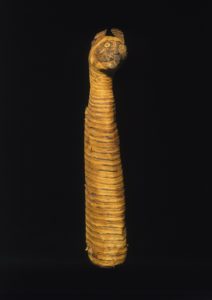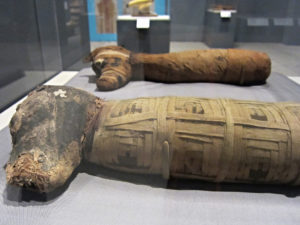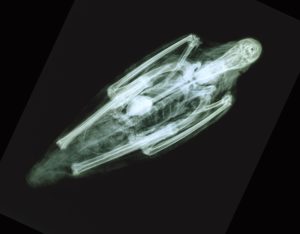
Try wrapping your head around this: excavators in Egypt have found four million cat mummies, seven million dog mummies, four million ibis mummies and tens of thousands of other mummified animals, big and small–including bulls, mice, snakes, baboons, lions, and even bugs!
Apparently, the ancient Egyptian philosophy of “Go Big or Go Home!” didn’t just apply to the pyramids.
Emory professor Johannes Kleiner, gave a fascinating lecture on animal mummification for the docents at the Michael C. Carlos Museum earlier today. At the Carlos, we have several small but interesting examples of animal mummification–kitten, falcon, puppy, crocodile–but I was agog to learn of the vast quantities discovered. Clearly, animal mummification was big business.
While there are certainly (and admittedly sweet) examples of treasured pets mummified to accompany their people into the afterworld, the vast majority of mummies were used as votive offerings. That means they were purchased by pilgrims who then brought them to temples likely hoping that the animals would act as intermediaries who would bring messages to the gods on behalf of the non-divine.
Most of the mummies were found in special cemeteries, usually near or under a temple. It’s unclear whether some of these temples served as nurseries or hatcheries–there is some evidence for that–but either way, the sheer number of sacrifices points to a veneration for the divine nature of animals.
As Kleiner pointed out, the ancient Egyptians didn’t believe that the individual animals themselves were divine but that they were the incarnations of the divine natures of some of the gods. Who else could “speak” so well on your behalf to Anubis, god of death and mummification, for example,but another dog?

It’s always been funny to me that many animal mummies have been discovered to be “fake”–i.e., they may be shaped like the full sized animal, but often they are stuffed with mud or just a bone or two. As I tell the children on tours, “There was no such thing as a ‘Better Business Bureau’ for mummification, so there was no protection against being cheated.”
Humans and cheating. Given the chance, people will try to get away with whatever they can for as long as they can. Nothing’s changed much, has it?

Kleiner also talked about animal mummies as food. It was quite common for tombs of the royal or noble to be stuffed with mummies meant to be cooked in the afterlife. Tut had hundreds of small containers of sides of beef for his consumption on “the other side” in his tomb. Other “delicacies” have been found, including doves, ducks, and geese.
Anyone who knows me knows I can’t cook worth a darn and once roasted a chicken with all the little packets of gizzards still inside (what? I didn’t know that’s where they were! I thought you had to buy them separately). Anyway, this idea of stuffing the inside of a bird with special packets of organs–used for making gravy, perhaps–goes back way farther than any one of us could have guessed. The Egyptians, it seems, started the practice.
Interestingly, no food mummies of fish or pork have been found in royal/noble tombs. Kleiner said we don’t know if this food was taboo, or just not included because that’s what the poor people ate.
Ah, humans and the need to be “better than” others based on wealth and class. Again, not much has changed over the millennia. Sigh.
Anyway, we learned a lot of fascinating facts related to the practice, but I’m not going to tell you all of them here–you will just have to let me give you a tour at the Carlos to hear the rest!
Or, if you’re in Tennessee, you can catch the traveling exhibit, Soulful Creatures: Animal Mummies in Ancient Egypt, at the Memphis Brooks Museum of Art through January 18. The exhibit then moves back to the Brooklyn Museum.



Leave a Reply